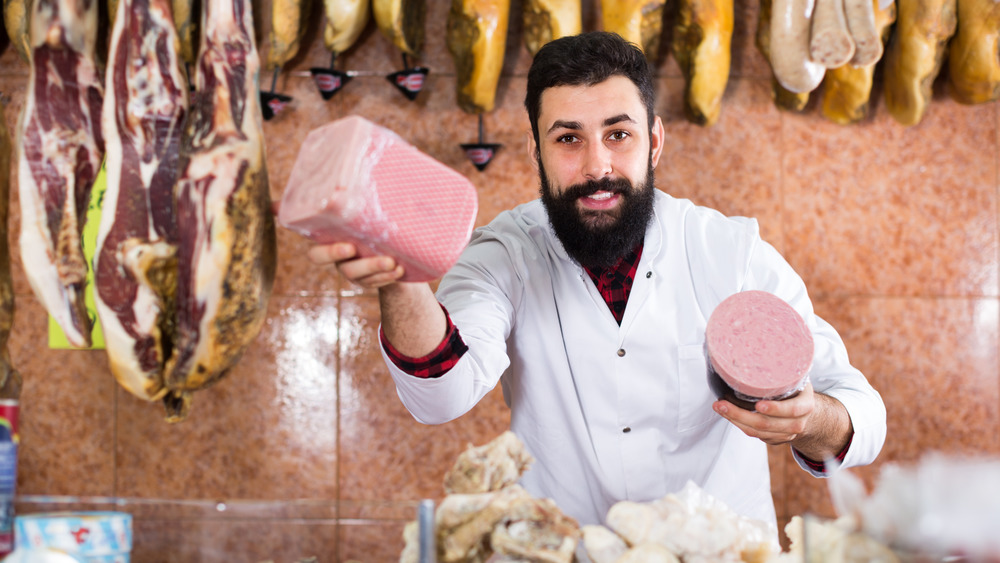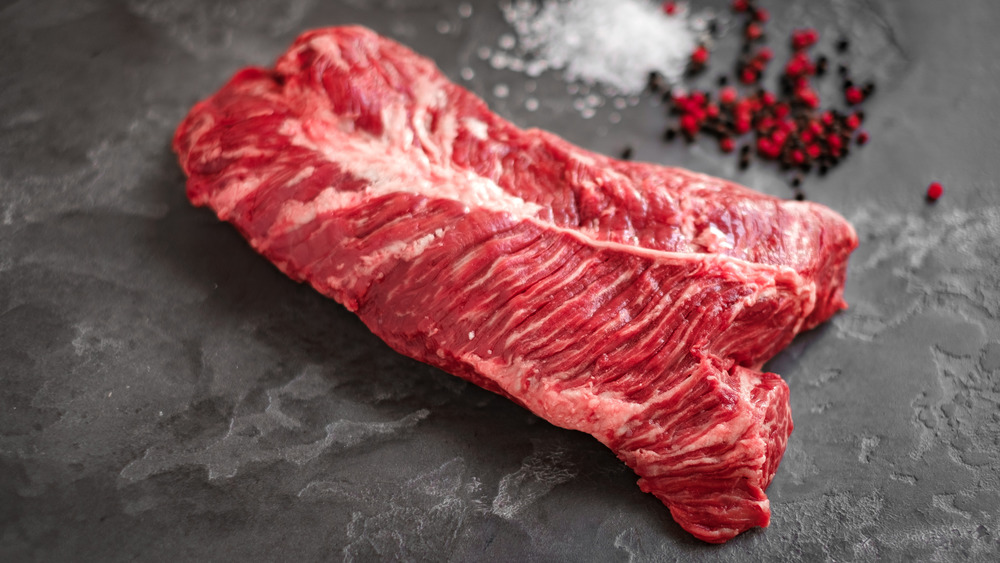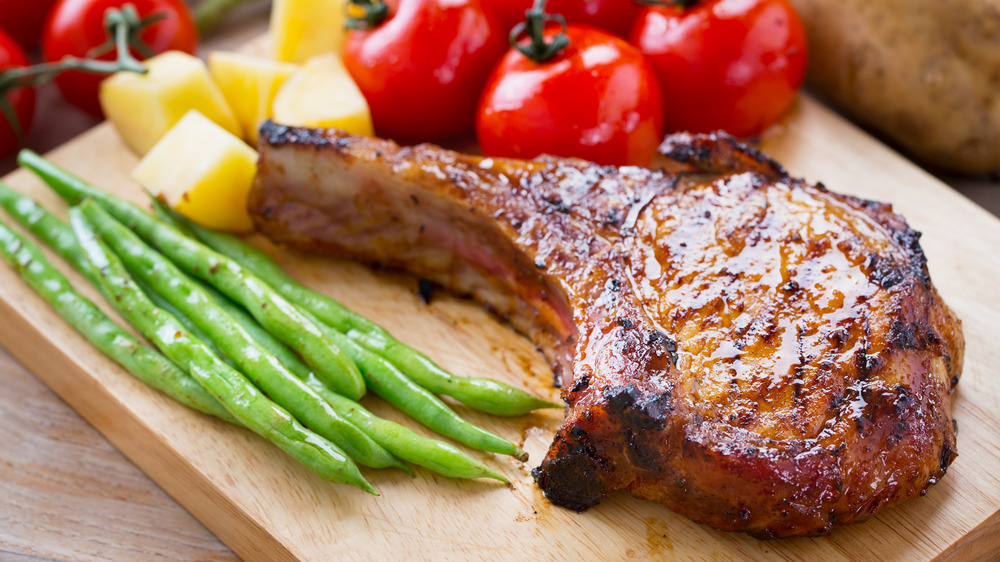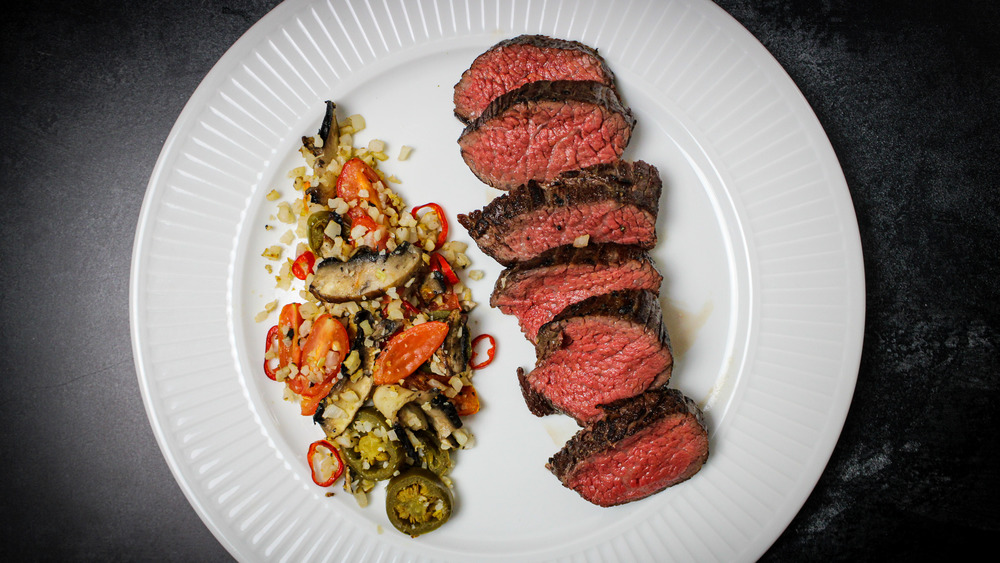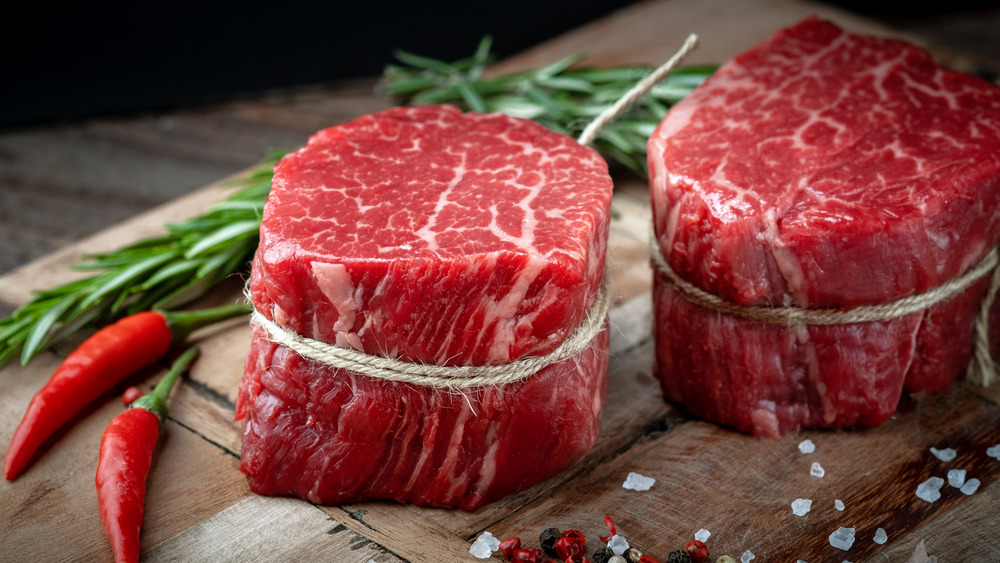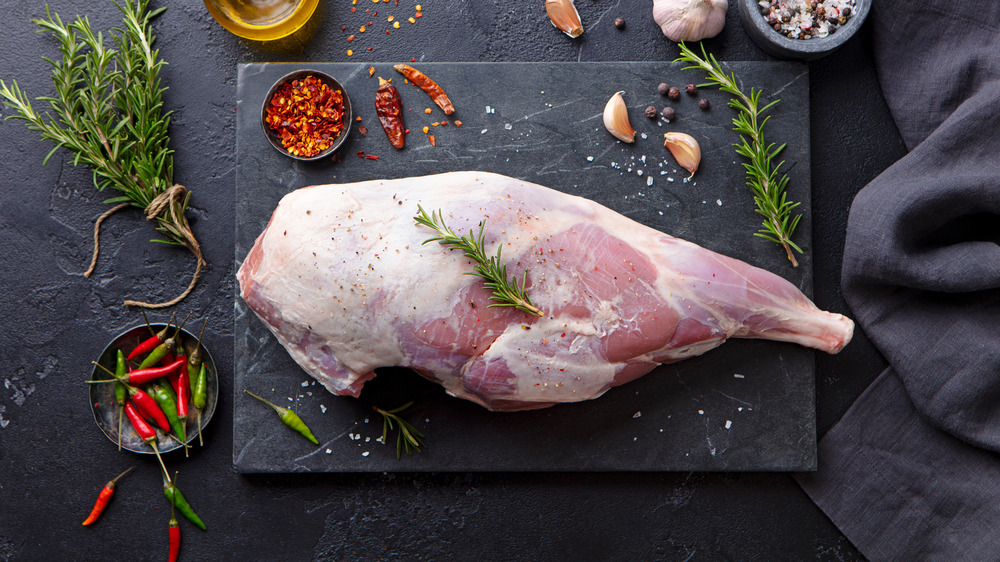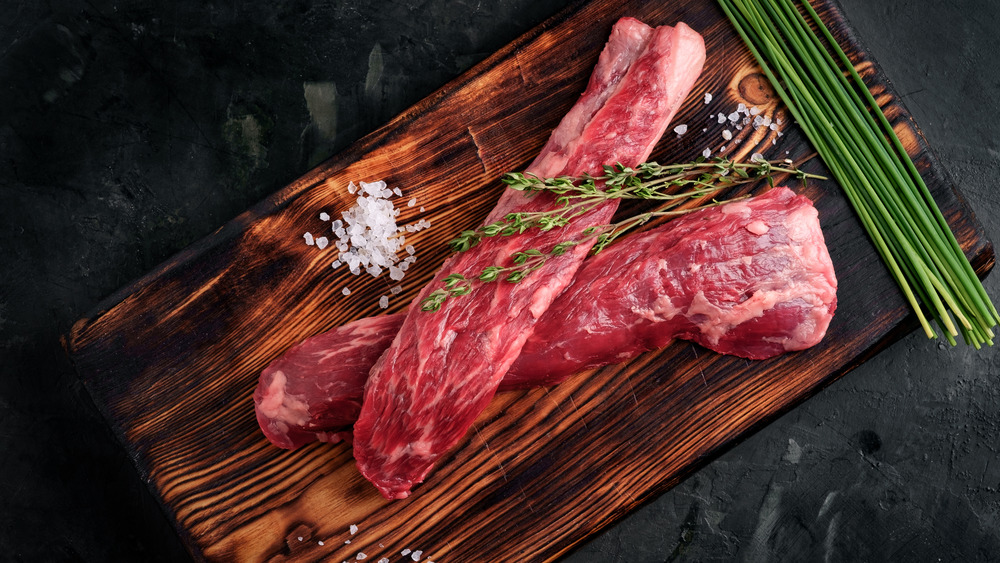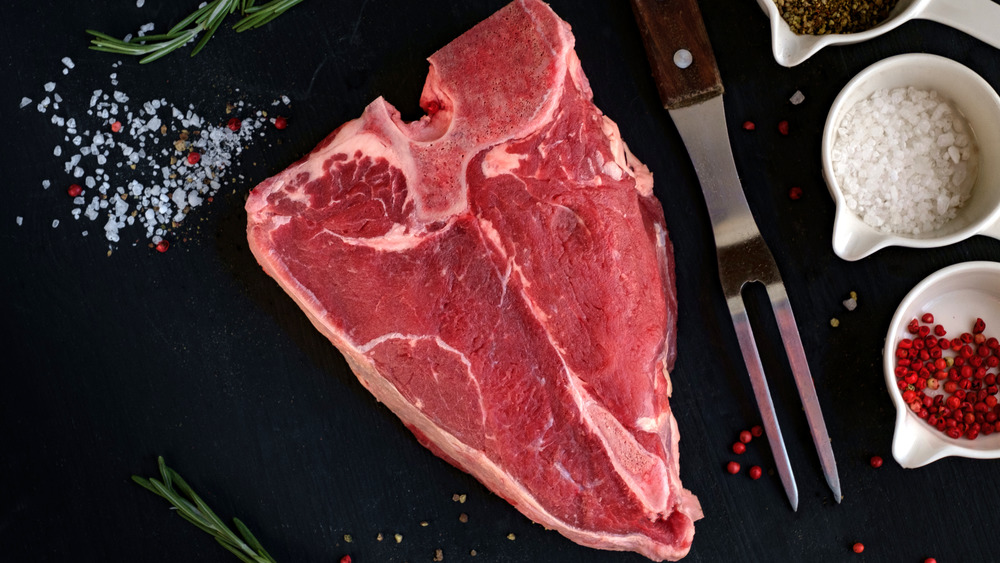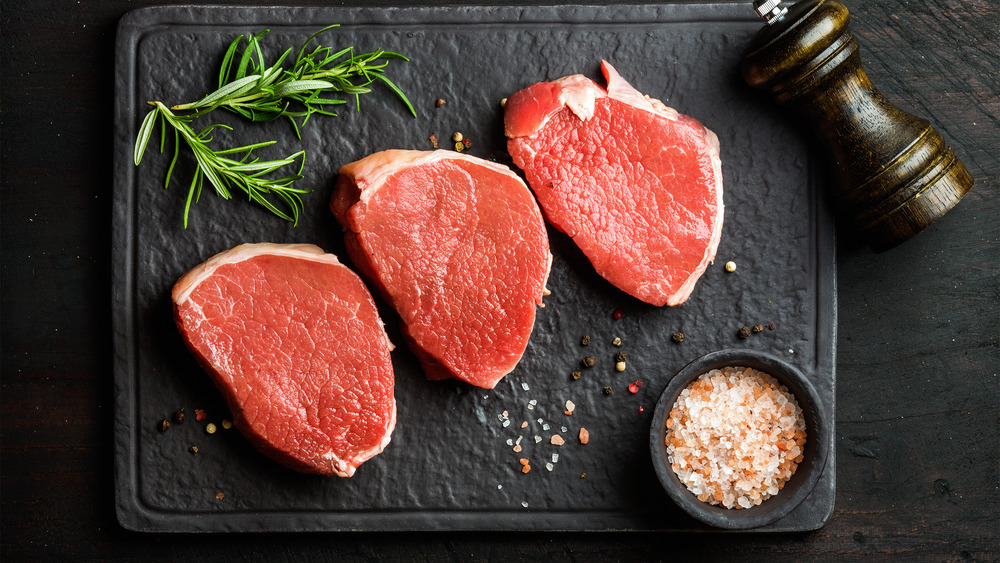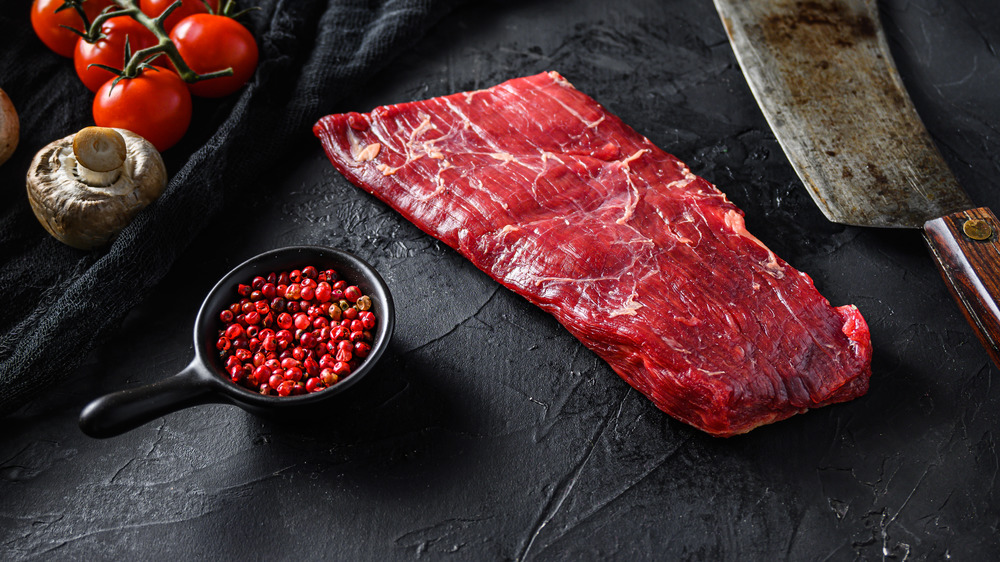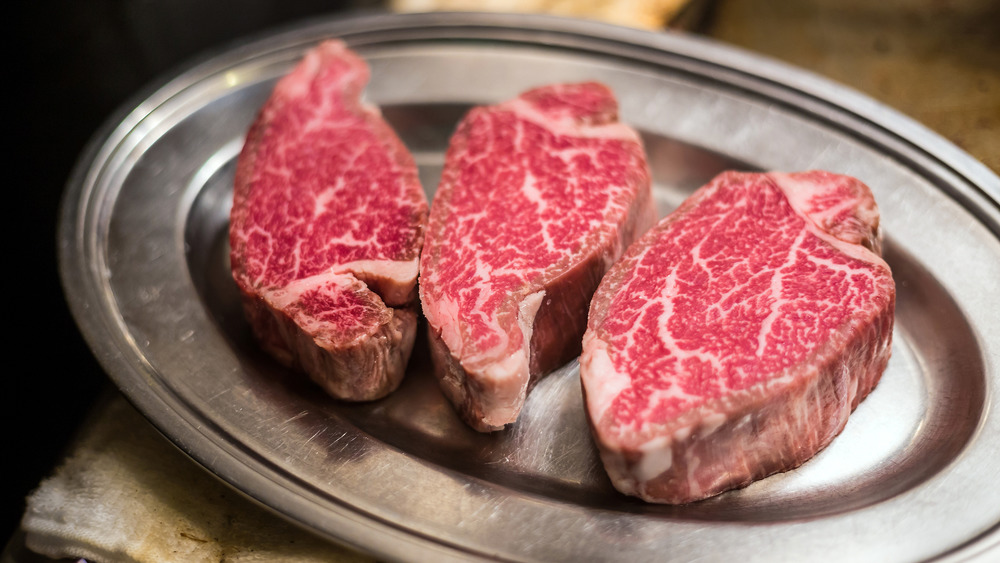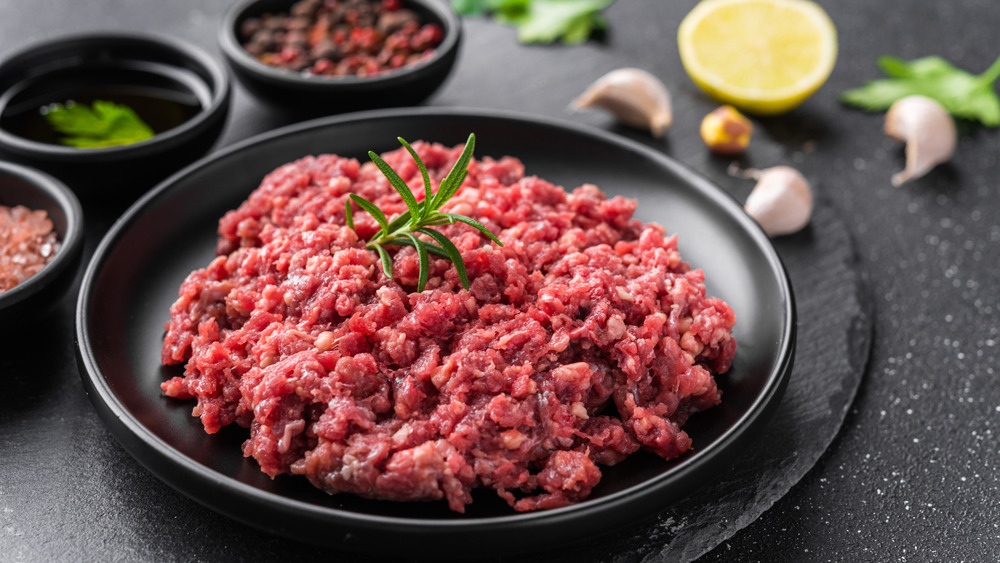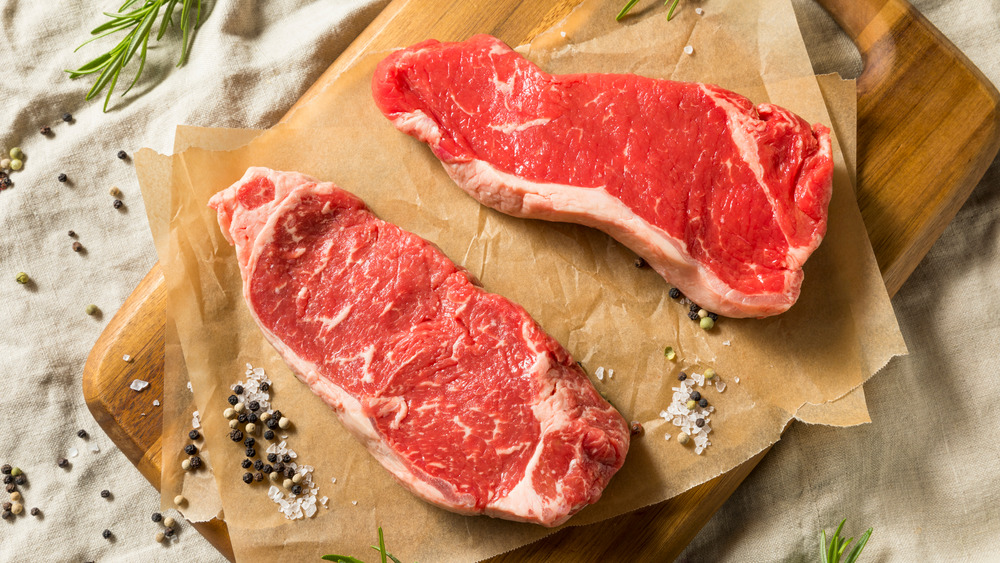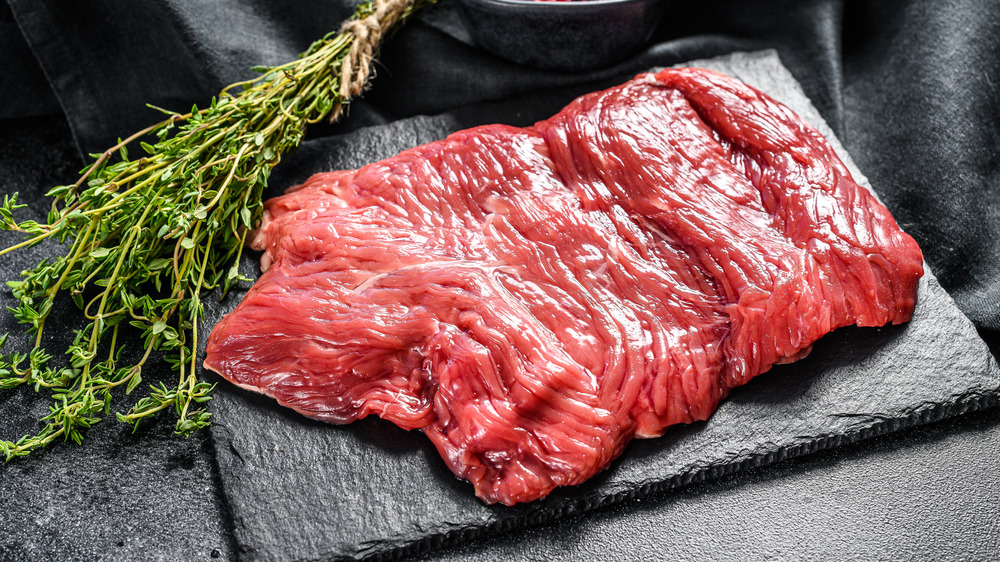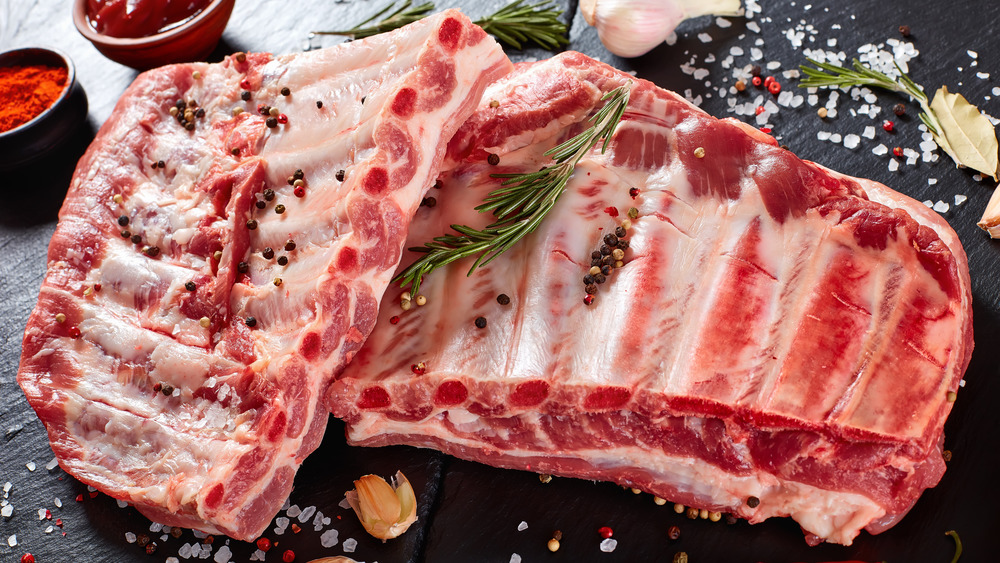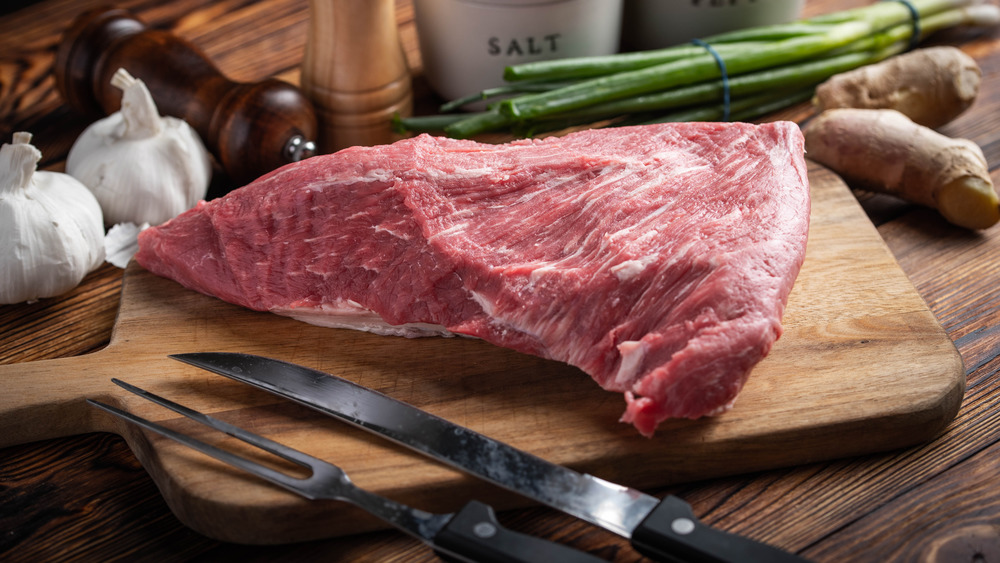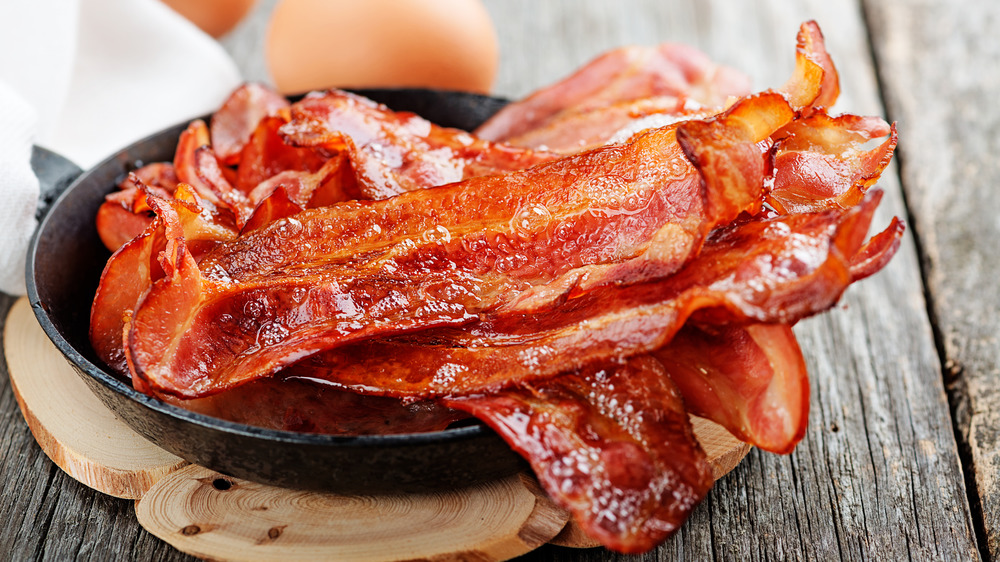8 Best And 8 Worst Cuts Of Meat To Buy In A Butcher's Shop
Common sense dictates that the absolute best place to acquire your meat is at the butcher's shop. Apart from the obviously vast selection of meat and meat-based delicacies, a trained and dedicated butcher can provide the kinds of tips and expertise you simply don't find from your average supermarket assistant. You can just walk into a good butcher's shop, have a meat-themed chat with the person behind the counter, and see what professionally recommended treats you walk out with.
However, not every delicious slab of meat is created equally. As such, they don't all necessitate an audience with a meat specialist. In fact, if you're after certain cuts, you might very well be able to avoid the butcher's altogether and pick your own ingredients from the grocery store. With this in mind, here's a handy guide to the best and worst cuts of meat to buy in a butcher's shop.
Best: Hanger steak
Hitting the butcher's shop can be a great way to get your mitts on some of the most underrated cuts of steak out there. You know — the ones that might not instantly strike you as delicious, but which are actually quite well-regarded among the professionals. Indeed, many chefs consider hanger steak to be the king of such cuts, courtesy of its combination of tenderness and intense flavor.
"The hanger steak comes from the plate, which is the lower belly of the animal, and literally 'hangs' from the diaphragm," Cory Harwell of Eleven Hospitality Group told Thrillist. "You'll find it to be rich and full with a hearty, beefy flavor, similar to that of a ribeye, but without the price tag." As such, the esteemed and flavorful cut is a perfect excuse for a visit to the butcher's, because, with a special ingredient like this, you'll also want a few tips from a pro. After all, butchers apparently know this cut particularly well, to a point that some say they have historically been tempted to take it home. As Executive Chef William DeMarco of CRUSH and La Cave Wine & Food Hideaway puts it: "It's also known as the butcher steak because the butchers used to keep it for themselves rather than sell it."
Worst: Pork chops
Sinking your teeth in a good pork chop is a culinary experience like few others. As Food 52 notes, it's a good all-around cut that can be cooked in a variety of ways. With a little skill and the right brine, your pork chops can taste like magic.
As a comparatively inexpensive protein that's can be turned into a delicious dinner with just three ingredients and a crock pot, pork chops are practically designed to be a "supermarket meat" — something you can pick up as you wander the isles, safe and secure in the knowledge that it's not going to set you back too much and that you can turn it into virtually whatever your palate happens to desire with reasonable effort. As such, while you're well within your rights to pick up some quality bone-in chops if you find yourself at the butcher's shop, they're hardly worth a visit by themselves.
Best: Teres major
Chances are, you won't find teres major unless you visit the butcher's shop, so if you want to find out what this little-known cut tastes like, an expert store should be your go-to choice (per Complete Carnivore). Teres major is simply the best-sounding name for a cut that also has slightly less impressive monikers like "mock tender". It's technically chuck, but unlike most other beef shoulder cuts, this particular muscle that connects the front shoulder and the shoulder blade is super tender, while still retaining plenty of that amazing chuck flavor. In fact, the butchers at St. Paul Meat Shop have outright stated that only the tenderloin beats teres major in terms of sheer tenderness — but teres major is cheaper and way more complex in taste.
The only downside of this succulent cut is that it's small and fairly rare, so you might have a hard time getting your hands on it. Then again, this is exactly the type of situation where your local butcher can and should come into play. After all, even if they don't carry teres major themselves, they may at least have an idea of how you can access it.
Worst: Filet mignon
You wouldn't expect to see the mighty filet mignon on the "worst" side of any meat-themed list, yet here we are. Chefs have been known to name it among one of the most overrated cuts of beef. "It's prized for its tenderness but it has no flavor because there's no intramuscular fat," executive chef Bryce Gilmore told Thrillist when he explained filet mignon's central fault.
While there's no denying filet mignon's tender structure, the whole "no flavor" thing is pretty damning when it comes to such a pricey cut. So, if you really want to grab a few of them, you can totally get them at the butcher's shop — but why would you want to? The butcher store is meat heaven with an absolute expert behind the counter. Why not use that filet mignon budget on something that tastes way, way better? We're betting the butcher will be all too happy to recommend you a thing or two, and chances are you'll get way more bang for your buck.
Best: All lamb cuts
Meat may be delicious, but it can also be a portal to a world of disappointment for the unwary home cook, especially if they're not familiar with the ingredient they're trying to manage. For instance, cooking lamb can be fairly difficult because many people aren't as familiar with its unique qualities as they are with meat such as beef. As such, choosing the right cut and knowing what you're doing with it can make the difference between dried-up, gamey horror and a dinner that sends everyone scrambling for seconds.
This makes lamb a quintessential butcher's shop purchase. Having a pro recommend the best cut for the job and give you a few pointers can be a total game-changer in your lamb-cooking game. As Easy Peasy Foodie notes, the butcher can also help you prep, say, a leg of lamb in a way that'll save you plenty of headaches later down the line.
Worst: Tenderloin
Per Thrillist, some chefs eschew filet mignon for its blandness, but at the end of the day, it is merely the small end of another sinner — the entire tenderloin. The main problem here seems to be that while the cut is as tender as its name suggests, its price tag and flavor simply don't match. "It's flavorless and has no texture, yet for some reason people are willing to pay absurd amounts of money for it," Chef Michael Fiorelli of Love & Salt spoke of the tenderloin. "I would never serve it in my restaurant."
That said, tenderloin does have a certain prestige, and no one's stopping you from getting some from the butcher's shop. However, at the end of the day, it's worth asking yourself: With a vast variety of amazingly delicious meat cuts at arm's reach, why would you bother picking the one with barely any taste?
Best: Porterhouse
If you're looking for an impressive steak, you can't go wrong with a porterhouse. According to The Spruce Eats, this hefty cut is one part New York strip and one part filet mignon, separated by a bone. Per Beef. It's What For Dinner, the gigantic combination is also known as "king steak," which should tell you everything there is to know about this bad boy's reputation.
This heaping helping of beef is no casual Tuesday lunch. Its eating and preparation are rare rituals, and as such, buying it should be one, too. Even if you somehow happen to live near a supermarket that carries prime porterhouse steaks, the one steak to rule them all practically demands to be bought from a butcher's shop, complete with a nice chat and possibly a few preparation pointers. Besides, there's also the fact that heading to the butcher's for all your porterhouse needs guarantees that the gigantic steak you're about to splurge on — not to mention spend a considerable time eating and digesting — will be top quality.
Worst: Round steak
If you find yourself stranded in some strange alternate reality where butcher's shops only sell beef round, there are ways to turn it into something edible, such as slow-cooking it into Swiss steak. In almost any other scenario, though, round steak is the one cut of steak you should probably avoid.
There are some glorious cuts of meat that achieve the Holy Grail of both flavor and tenderness. Unfortunately, the various parts of round sit firmly on the other end of the spectrum, to the point that The Splendid Table has called eye of round "one of the few unredeemable cuts of meat." All in all, round is the worst cut of steak out there, thanks to its toughness and utter lack of flavor. Granted, it's inexpensive, so there's that. Still, with several far superior budget cuts of steak out there, it's worth looking into other options.
Best: Vacio steak
Vacio steak is one of those cuts that you really want to go to the butcher's to get, because, as The Spruce Eats tells us, this delicious, marbled meat is a popular butcher's cut with some tricks up its sleeve. For the uninitiated, the name might sound a tad mysterious, but that's just how they call it in Argentina. This particular cut holds more than one passport and is also commonly known as bavette, a tasty steak cut from French cuisine. It's a fat-encased flap cut from right under the loin, perfectly placed for the cut to develop its signature tender mouthfeel and strong flavor it's so prized for among those in the know.
Incidentally, if you feel like going the whole nine yards and preparing vacio steak the traditional Argentinian way, it's absolutely worth looking into the asado grilling method, which is one of the weirder ways to cook steak out there.
Worst: Kobe or wagyu
No one's saying that the legendary Kobe beef or other varieties of Japanese wagyu aren't excellent. They absolutely are — you just might find it hard to get hold of them, because there's a lot of fake wagyu going around. The complex meat grading system used in Japan doesn't properly translate to the U.S. market, and the terms "Kobe" and "wagyu" aren't regulated stateside as well as they arguably should. This has created a situation where the cheap Kobe beef at restaurants is invariably fake, and the introduction of the "American wagyu" Angus hybrid has complicated things even further.
Marching to the butcher's store and ordering wagyu may well yield delicious results. At the very least, you'll probably get some decently marbled, tender steak. However, if eating the real thing is on your bucket list, be aware that you'll probably have to do a lot of homework before you can be reasonably sure that you're getting the meat that you want. In the case of true Kobe beef, it might be quicker to just visit one of the precious few U.S. restaurants that are allowed to sell the stuff and have the paperwork to prove it.
Best: Ground beef
Ground beef is the very definition of casual eating, and it's plentiful in any and all grocery stores. It doesn't seem like something you'd necessarily head to the butcher's shop for — though you absolutely should. Per The Kitchn, ground beef is one of the more likely culprits for an unwelcome bout of food poisoning, thanks to the unfortunate fact that its very structure makes it a safe haven for E. coli and other nasty bacteria, which become part of the mixture when the meat is ground. There's also the fact that pre-packaged ground beef invariably comes from lots of different cows, which dramatically raises the risk of one of them being contaminated and thus contaminating the whole package.
As such, heading to the butcher's and asking them to grind the meat right in front of you is your best bet for getting as safe and tasty ground beef as possible, according to The Spruce Eats.
Worst: New York Strip
The New York strip is a lovely strip steak that's a delicious cut in its own right, and so associated with the basic concept of "steak" that it's one of the most popular cuts out there (via Beef2Live). As such, the New York strip is omnipresent in restaurants and at supermarket meat sections, and a butcher who can't provide it is likely either making some sort of statement or just hopelessly out of their element.
Here's the question, though: Why would you head to the butcher's to get it in the first place? Why go to a specialty shop for something you can get basically anywhere? Sure, if you're really hankering for a New York strip and absolutely, positively need to make sure that you get the freshest, most locally sourced grass-fed meat available to you, it's understandable. Then again, when you actually enter the shop, there's a fair chance that you'll find something way more exciting to tickle your fancy — and if you don't, at least ask for the butcher's recommendations before settling for the steak you've had so many times before.
Best: Skirt steak
Have you ever wondered why skirt steak tastes awesome at the restaurant, but when you buy it from the store, it's a thin, fatty, membrane-streaked mess that you need to painstakingly clean up? You may not be imagining things, because the two are usually very different beasts. There are actually two versions of this affordable and tasty plate cut: inside skirt and outside skirt. The former is the small, tricky one that you tend to find at the supermarket. Meanwhile, outside skirt also needs some trimming, but it tends to be easier to prep and is considerably bigger.
As you can probably guess, the outside skirt is the cut that restaurants generally prefer. it can be quite tricky to find in a supermarket because the demand is so high. As such, the correct move here is to head to the butcher's shop and see if they can hook you up with the good stuff.
Worst: Pork Ribs
Ribs are messy, versatile, delicious, and fun. They're cheap, readily available at every grocery store, and their taste is pretty much defined by the way they're prepared. As such, you should have precious few problems turning them into a delicious meal, as long as you remember to avoid the most common rib-cooking mistakes. Because they're so ever-present and can be prepared in a multitude of mouth-watering ways, there's no real need to head to your local butcher's shop specifically for ribs.
Of course, there are exceptions and special occasions, like if you're planning to buy an absolute ton of racks and hope to get the butcher to apply the dry rub as well. It's also worth noting that there are surprisingly many different types of ribs, so if you're after a very specific cut that you're not sure your supermarket will carry, the butcher's shop can help.
Best: Tri-tip
Some of the tastiest cuts are also small and highly sought-after. Take the esteemed tri-tip, which Santa Maria Valley describes as the triangular bit from the very bottom of the sirloin. The cut somehow manages to be simultaneously tender, lean, and ultra-tasty, but because even a huge cow only yields one 2.5-pound tri-tip per side, it can be in shorter supply than other, larger cuts.
California's own steak does have its peculiarities. Until the 1950s, butchers used to consider tri-tip a bit of a spare piece in the cow puzzle, preferring to chop or grind it for stew or burger meat, and even after its value as a steak cut became apparent, it needs to be cooked properly in order to bring out its best properties. As such, this is one cut you'd do well to buy from the local butcher, who can give you some pointers on how to treat it — and if you're going for the full tri-tip small roast, they can also cut it into steaks should you so desire.
Worst: Bacon
As one of the precious few food items with its own line of ridiculous merchandise, bacon is an institution that's as pervasive in pop culture as it is in the kitchen. There are tons of different varieties of bacon (via Bacon Scouts), cut from an impressive array of pig parts. As such, it seems obvious that a trip to the butcher's shop would reward you with countless, delicious varieties of bacon, enabling one to finally go Full Bacon and gorge on different cuts like someone with less porcine appetites might taste wines.
And sure, you probably could. But why bother? The thing about bacon is that the stripes of fatty pork belly you probably crave are a very specific type of bacon called streaky bacon, which is readily available anywhere groceries are sold. Even if you're looking for, say, Canadian bacon or Italian pancetta, the sheer popularity of bacon means that a well-equipped supermarket can likely provide, while gently nudging you toward the bacon-flavored salt isle. Walmart's bacon-themed selection is eye-watering. Aldi can hook you up with bacon coffee.
While it's totally fine to get classy butcher bacon every once in a while, this is one meat treat your supermarket will carry in tons of varieties, and the selection could very well be even wider — or, at the very least, stranger — than at a butcher's.
